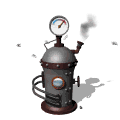|
Replace or clean your furnace filter. You should replace or clean your furnace filter(s) three or four times yearly. This is a quick, easy job every homeowner or tenant can do. A new filter makes your furnace more energy-efficient and saves money, too. A furnace that is not running at peak performance can be deadly. Carbon Monoxide is a natural product of incomplete combustion. Virtually every gas furnace produces some Carbon Monoxide, which is usually carried away from your home through the furnace's venting. A clean, efficiently burning gas furnace produces very small amounts of carbon monoxide, while a dirty, inefficiently burning one can produce deadly amounts. Carbon Monoxide is odorless and colorless. It causes flu-like symptoms, disorientation, confusion, and even death. It is highly recommended that you have your furnace cleaned and checked every year. The older the furnace, the more important this service is. Newer gas furnaces are equipped with many features that shut the furnace off when a problem is detected. Older furnaces have no such devices. Over time, furnaces can develop small cracks in the combustion chamber. These cracks may not be visible to the naked eye. It is through these cracks that Carbon Monoxide can leak into your home. It is also important to change your furnace filter regularly. The filter usually is found just inside the front cover of the furnace. It may have its own access door on the front of the furnace. A clean filter will help your furnace burn more efficiently, and will help keep dust from being circulated through your home.
How to Tell When Your Furnace Is Not Feeling Well
grinding, chattering sounds from relays (signifying electrical problems), a burner that huffs and puffs, banging (delayed ignition), or clunking and bumping (cracked belt passing over pulleys)? The solution: A good rule of thumb: if it's an unusual noise, it's a problem. Unless you're completely comfortable with changing a relay or a belt, call your service technician. Carbon Monoxide: It's colorless, odorless and tasteless, and it can kill you if it's concentrated enough. It is caused by a lack of oxygen or a disruption of the fuel-burning process. The solutions: Your furnace breathes, just like you. Provide adequate ventilation to the unit and consider installing a fresh-air (combustion) intake. Use carbon monoxide detectors, combined with routine maintenance checks by qualified service technicians (mark them on your calendar). Yellow Flame: That flame should be sharp and blue, clean and stable, burning as purely as possible. A yellow flame indicates dirt in the burner, which prevents it from mixing the gas and air properly. The solution: Call your technician to thoroughly test the system and clean it. Dusty Smell: You turn up the thermostat and within minutes, your home is filled with a dry, dusty smell. The solutions: 1) Don't worry; it's just burning the dust out of the combustion chamber. Change your filter . 2) If it's a constant odor, call your technician. 3) If it smells like gas, call your utility company. Backdrafting/Negative Pressure: Negative pressure results when you take air out of the house by using oxygen faster than air can enter the house. Backdrafting is a natural consequence of negative pressure; air rushes into the house through the chimney, effectively choking off the natural process of venting. The solution: Run a combustible air duct to the unit from the outside. adapted from an article by David Carlson, Lennox Industries Beware of Carbon Monoxide Poisoning A clean, efficiently running gas furnace provides safe, economical heat. A gas furnace that is not running at peak performance can be deadly. Carbon Monoxide is a natural product of incomplete combustion. That includes wood, kerosene, gasoline, oil, propane, or natural gas. Virtually every gas furnace produces some Carbon Monoxide, which is usually carried away from your home through the furnace's venting. A clean, efficiently burning gas furnace produces very small amounts of carbon monoxide, while a dirty, inefficiently burning one can produce deadly amounts. CO is a toxic, tasteless, colorless, and odorless gas. Even small amounts can cause severe illness and even death. Symptoms include headaches, dizziness, faintness, drowsiness, pain in the ears, or seeing spots. Many people often mistake CO symptoms for the flu. If you or any of your family members are experiencing flu-like symptoms that seem to disappear when you leave your home, have your furnace checked immediately. If you suspect a carbon monoxide problem, open the windows and leave the home at once. Fireplace or Wood Burning Stove Cool Links About Heating, Cooling, Energy Efficiency
Read
About Other Ways To Lower Your Energy
Analyzer is a free energy analysis tool for
your
|




